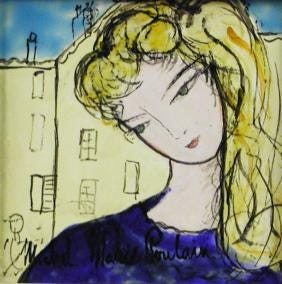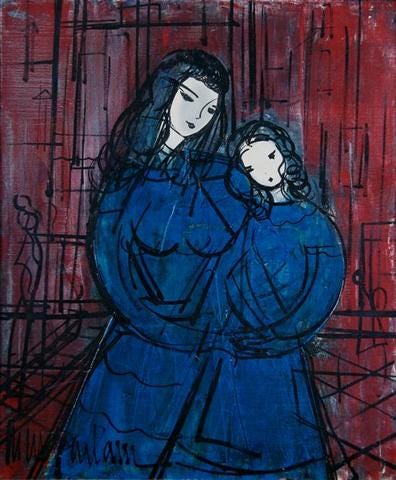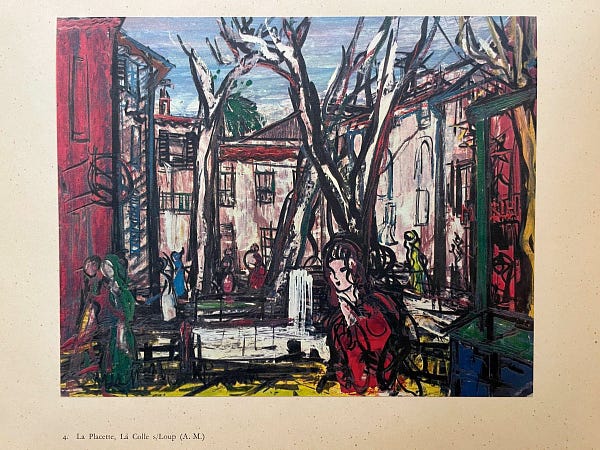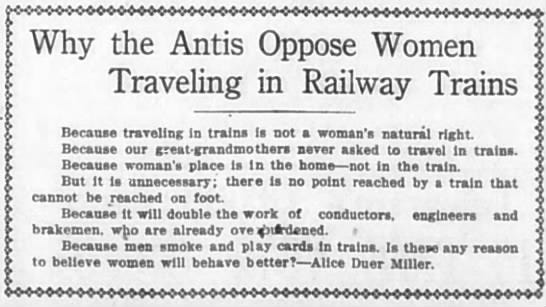Lost Modernist Women: Celebrating Women's History Month with Four Women Trailblazers!
Learn more about Alice Duer Miller, Avril Coleridge-Taylor, Michel-Marie Poulain & Esther Eng!
March is Women’s History Month! Time for a new installment of my series, Lost Modernist Women, celebrating modernist women who are often overlooked or forgotten by the mainstream history books.
To read (or listen to) the first article in the series, Lost Modernist Women: Viola Paradise, click here.
To read the second article, Lost Modernist Women: Adelaide Crapsey, click here.
Each of these two previous articles focused on an individual modernist woman who deserves our attention. But because this is Women’s History Month, I couldn’t pick just one! So below are four extraordinary women trailblazers from the modernist era. What is remembered, lives. May they be remembered!
Alice Duer Miller (1874-1942): Suffragist Poet, Activist, Novelist & Screenwriter
If you want to know more about the colossal obstacles faced by those valiant suffragists trying to secure a woman’s right to vote, then go ask Alice. Alice Duer Miller (1874-1942) was a prolific writer in numerous genres and a lifelong activist for women’s rights. Graduating from Barnard College in 1895 (with degrees in Mathematics and Astronomy no less), Miller helped pay for her education by selling novels and essays to magazines like Harper’s and Scribner’s. She then became a full-time writer, an activist for women's suffrage, and a member of the famed Algonquin Round Table (where I suspect she influenced Dorothy Parker). In total, she wrote 44 books and at least seven screenplays. 28 films (in five languages!) were based on her novels, including the classic 1944 war film, The White Cliffs of Dover.
But I want to focus on an early book of poetry and satire, Are Women People? A Book of Rhymes for Suffrage Times, published in 1915. With scathing wit and irrefutable logic, she systematically demolishes all of the arguments against women having the right to vote. The entire book is worth a read (or a listen), but here are three of my favorites:
Why We Oppose Votes for Men by Alice Duer Miller
1. Because man’s place is the armory.
2. Because no really manly man wants to settle any question otherwise than by fighting about it.
3. Because if men should adopt peaceable methods women will no longer look up to them.
4. Because men will lose their charm if they step out of their natural sphere and interest themselves in other matters than feats of arms, uniforms and drums.
5. Because men are too emotional to vote. Their conduct at baseball games and political conventions shows this, while their innate tendency to appeal to force renders them particularly unfit for the task of government.
Our Idea of Nothing at All
by Alice Duer Miller
(“I am opposed to woman suffrage, but I am not opposed to woman.”
— Anti-suffrage speech of Mr. Webb of North Carolina.)
O women, have you heard the news
Of charity and grace?
Look, look how joy and gratitude
Are beaming in my face!
For Mr. Webb is not opposed
To woman in her place!
O Mr. Webb, how kind you are
To let us live at all,
To let us light the kitchen range
And tidy up the hall;
To tolerate the female sex
In spite of Adam’s fall.
O girls, suppose that Mr. Webb
Should alter his decree!
Suppose he were opposed to us—
Opposed to you and me.
What would be left for us to do—
Except to cease to be?To read more, check out Alice Duer Miller’s entire collection of satirical feminist verse from 1915, Are Women People? A Book of Rhymes for Suffrage Times, for free via Project Gutenberg! Or listen to a free audiobook version via LibriVox!
Avril Coleridge-Taylor (1903-1998): Classical Composer, Conductor & Pianist
Though Avril Coleridge-Taylor was the daughter of famed Black British composer, Samuel Coleridge-Taylor, she was also a musical prodigy and genius in her own right. She started composing at the age of 12! Much later, she became known as one of Britain’s acclaimed conductors, guest conducting for both the BBC Orchestra and the London Symphony Orchestra. In the 1930s, she was also the first female conductor of the H.M.S. Royal Marines and the first female conductor to conduct at the bandstand in London’s Hyde Park. And in 1941, she founded the Coleridge-Taylor Symphony Orchestra with the express intent to employ musicians in need during the depression.
Her importance as a trailblazing biracial female conductor would already be enough to deserve a place in the history books. However, after decades of neglect, it is her exquisitely beautiful classical compositions that need to be heard by a larger audience. While her songs, chamber music, orchestral music and keyboard works were widely performed in the 1920s and 1930s, and she continued composing and arranging well into the 1960s, it is only recently that her work is thankfully being rediscovered and performed again. Years after her death in 1998, several boxes containing the sheet music of her compositions were discovered by her family.
And now, thanks to the Chineke! Orchestra and other progressive orchestras and musicians, her works are finally being performed (and recorded!) again, often for the first time in many decades. Below you can listen to Chineke! Orchestra’s performance of Sussex Landscape, her gorgeous tone poem from 1936, as well as the lovely Nocturne, performed by pianist (and champion of women composers) Antonio Oyarzabal. Hopefully we will hear more of Avril Coleridge-Taylor’s music in the coming years!
Michel-Marie Poulain (1906-1991): Groundbreaking Painter & Performer
Now here’s another lost trailblazer for the history books! In 2021 I was searching for information about trans artists from the modernist era. I only knew about Lili Elbe, the Danish painter and subject of the 2015 film, The Danish Girl (though I suspected, correctly, that there were numerous other examples). I then stumbled across a Wikipedia biography that I have since learned was created by a Twitter user named Yavien. Here’s their original tweet:





I then found another online biography of Michel-Marie Poulain from an incredibly detailed and invaluable resource, A Gender Variance Who's Who (Subtitle: “Essays on trans, intersex, cis and other persons and topics from a trans perspective.......All human life is here.”), created by Zagria, a historian and encyclopedist whose massive ongoing trans history project has been going strong since 2008. Her bio of Michel-Marie Poulain was written in 2009.
Thank you Yavien and Zagria, for helping to bring this otherwise lost modernist woman to a wider audience!
Michel-Marie Poulain was a fascinating artist with a fascinating life. She attended girls’ schools until presumably being forced to attend an all-boys’ high school (where she refused to cut her long hair). Later, she became a cabaret performer, where she met her wife and lifelong partner Solange, with whom she had a daughter, Michele. In the 1930s, her paintings were shown at all of the major Paris salons and exhibitions. During WWII, she served as a senior-sergeant and was interred by the Germans in a prisoner-of-war camp, which she escaped in 1941.
She completed her transition/gender affirmation in 1946, staying with her wife and child. She became a fashion model, though she also continued painting (eventually opening her own art gallery in Cannes) and performing in the cabaret (she would later own her own nightclub in Paris). She also made stained-glass windows for numerous churches and chapels. Her paintings feature beautiful portraits of women, often in romantic pairs (including numerous paintings of two women with a female child) or groupings that imply an all-female bar or cabaret (including paintings of women wearing skirts or dresses dancing with other women dressed as sailors).
Much of her work can be found online. Below are just a few examples. To see more, try a Google image search or check out the Michel-Marie Poulain Page on Facebook for many examples of her paintings and artwork!









Esther Eng (1914-1970): Pioneering Film Director, Producer & Restaurateur
At a time when there was literally only one woman directing Hollywood films (amazing trailblazer Dorothy Arzner), San Francisco-born Esther Eng was directing, producing and distributing Chinese-language films in both the United States and Hong Kong!
Esther Eng was unstoppable. The granddaughter of Chinese immigrants, she started producing films with her father’s Cantonese-language production company at the age of 19. By 22, she was ready to move to Hong Kong and direct her first film! Openly lesbian, she had short hair (often described as a “boyish” or “masculine” bob), wore slacks and men’s jackets, and had romantic relationships with several of her lead actresses. But Esther Eng did not allow the barriers of race or gender, language or culture, sexuality or finances, stop her from what she wanted to do. She directed nine films in the 1930s and 1940s (including a film with an all-female cast that premiered several months before Hollywood tried - or copied? - the same premise with The Women), as well as a final film in 1961. She was a media sensation in Hong Kong, and a well-known figure throughout the Chinese diaspora.
And when she stopped making films in 1950, Eng went on to become a successful restaurateur, owning and operating five incredibly popular restaurants in Manhattan, with a celebrity clientele (including Marlon Brando, Tennessee Williams, Walter Winchell and Anna Magnani). One of her restaurants can even be spotted on the cover of Madonna’s first single, “Everybody”! To see the album cover, as well as Esther Eng’s delicious recipe for her Chinese Five-Spice Braised Beef Short Ribs, check out the “The Elegant Life of Esther Eng” at the blog Forever a Pleasure.
To learn more about Esther Eng’s remarkable story (as well as fellow queer cinematic pioneers Anna May Wong and Dorothy Arzner), see the wonderful documentary, Golden Gate Girls, directed by S. Louisa Wei [Wei Shiyu] and available for rent on Vimeo:
For more recipes (including that mouthwatering recipe for Esther Eng’s Chinese Five-Spice Braised Beef Short Ribs) and more fascinating women’s history, here’s a fun and interesting book to dive into (love the title!):
A Woman's Place: The Inventors, Rumrunners, Lawbreakers, Scientists, and Single Moms Who Changed the World with Food by Deepi Ahluwalia & Stef Ferrari, illustrated by Jessica Olah









